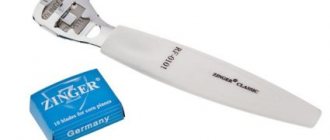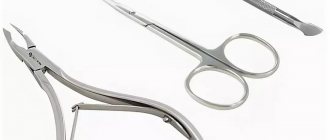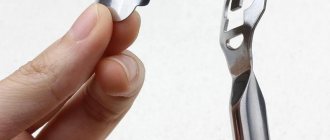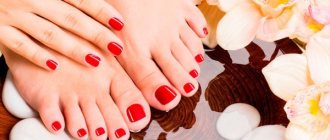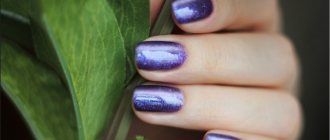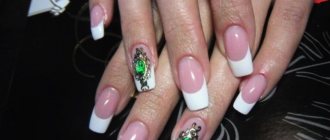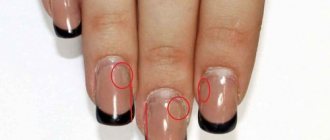Currently, many beauty salons offer their services. Almost every such organization can give you a manicure and pedicure. This is the treatment of hands and feet, respectively, using caring elements. In addition to removing dead skin, the master pays special attention to the nails. In beauty salons, hardware pedicures are increasingly being performed. Step-by-step instructions with photos will be presented to your attention in the article. You will learn about the features of the procedure and the basic rules.
Many representatives of the fairer sex try to save their time and money by refusing to visit beauty salons. They do pedicures at home. Step-by-step instructions for this processing will also be described below. Another reason for refusing salon services is the fear of infection. After all, through instruments that have not been sterilized by the master, you can get an infection from the previous guest.
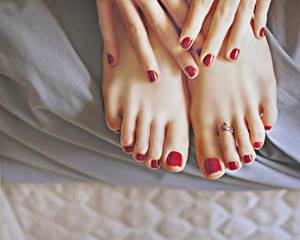
Should you do a pedicure at home yourself?
There is no clear opinion on this matter. Some people believe that home treatment of nails and feet is much safer than salon services. Others are sure that you can do the manipulation incorrectly with your own hands. As a result, irreparable consequences will arise.
Whether it is worth treating the legs yourself is a personal matter for everyone. In any case, you need to know the principle of operation. The instructions below will tell you about this. Note that the algorithm for performing salon and home pedicures is very different.
Pedicure at home
What will you need to carry out the manipulation? This is the question that arises first. The simplest and most popular way to treat your fingers is a wet manicure. To carry it out, you will need tools (scissors, tweezers, files, buffs, etc.), as well as a bowl of liquid. To soak the skin, you can use special salt and nutrient solutions. They are purchased ready-made. If desired, you can use regular soapy water.
In addition to the products described, you will need a cloth, a degreaser and a coating that will be applied to the plate. If desired, you can use moisturizing formulations and nourishing oils for the cuticle and skin. Let's look at how to do a pedicure at home with your own hands. Step-by-step instructions are in front of you.
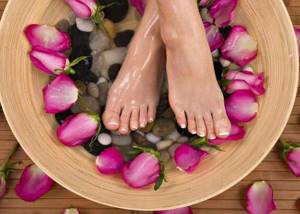
Tools
To do a classic pedicure at home, you need to prepare the following tools:
- Foot bath or regular basin;
- Several sanding files with different grits;
- Nail file;
- Tool for removing cuticles (this can be scissors, nippers or a trimmer);
- Disinfectant;
- Foot scrub;
- Nourishing composition for skin;
- Various nail coatings (base coat, hardener, colored varnish if desired).
A classic pedicure is best done in the evening, before bed. If this is not possible, you should set aside at least two hours to completely relax your legs, then the effect of the procedure will be much higher.
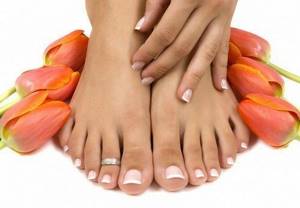
Softening rough skin
Pour the softening liquid into the bowl. After this, lower your legs into it. Some people prefer to use refillable formulations. They look like varnishes or pencils. These products lubricate the cuticle around the nail plate. Under the influence of the unique composition, the skin softens. After this, you can remove it without much difficulty.
Softening the cuticle with the help of special means requires a strictly specified time. Some formulations require exposure to the skin for 15 minutes, others act after just 5. If you do a pedicure at home with your own hands (an easy way for beginners), you will most likely choose softening with water. This effect on the skin should occur within 20 minutes.
Ongoing treatments to maintain soft feet
You must remember:
- Foot socks must be made from natural fabrics better than cotton;
- You need to soak the skin in water without allowing the accordion effect;
- If there are cracks or wounds on your feet, do not use acidic ingredients;
- All these recipes are guaranteed to make your skin soft, but for this you need to do the procedures regularly.
Homemade bath to soften feet using soda:
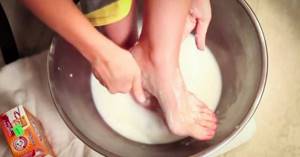
You will need a product common in our kitchens - baking soda! Add 4 tablespoons of baking soda to warm water and soak your feet in this solution for about half an hour (the skin should steam, but not shrink). After steaming, apply patchouli or sandalwood essential oil.
For maximum benefits, you can add bath salts (sea salts). Salt helps soften the skin and relax the muscles.
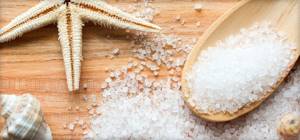
Repeat this procedure regularly! Sea salt with lavender extract is especially relaxing; this steaming before bed will allow you to completely let go of your thoughts and fully relax. Rub your legs with your hands to circulate the blood and relieve fatigue. You will immediately feel light, especially after a day spent in heels.
Banana puree mask for feet and heels (softening):

Banana is a tropical fruit that boasts a number of health benefits. It will also help cure rough skin on your feet.
Grind a ripe banana with a blender (or fork), add a tablespoon of honey to the puree and apply the resulting banana pulp evenly on your feet. Let it dry for 10-5 minutes and then rinse with warm water. Apply nourishing cream 20 minutes after the mask. Carry out this procedure once a week, preferably before bed, and get the desired result - soft heels.
Daily cleansing procedures (heel polishing):
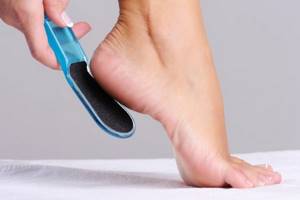
It is very important to regularly practice simple hygiene practices, such as scrubbing your feet with a buffing grater. This will prevent dead skin from accumulating on your feet and will also protect your skin from drying out and flaking. This procedure will take no more than 6 minutes for both feet, but it is thanks to it that the skin will become smooth.
All you need is to rub your feet while showering with a grater (before treating your heels, apply liquid soap or shower gel to the grater, this is mandatory). The hardness of the grater-polishing should not be higher than 100/180 grit. Once you're done, let your feet dry and moisturize them well with cream.
Wearing socks during sleep will help maintain the nourishing effect of the cream.
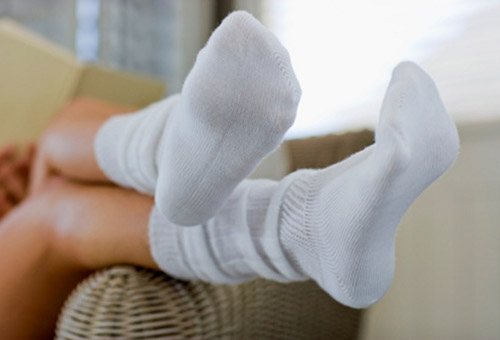
Foot massage with olive oil to soften:

Olive oil is an excellent moisturizer, especially for dry skin. To use olive oil, your feet must be clean. The easiest way is to dip a cotton ball in olive oil and apply it to the rough areas. Gently massage your feet in a circular motion to restore blood circulation. Once you're done, put on the wrap and a pair of warm socks on top and let your skin absorb the oil. After an hour, rinse your feet. Massage your feet with olive oil every other day.
For maximum benefits, leave the oil on overnight (but use it without film for no more than an hour; you shouldn’t soften your feet too much) and wash off the next morning.

We use vinegar to steam out old skin on the feet:
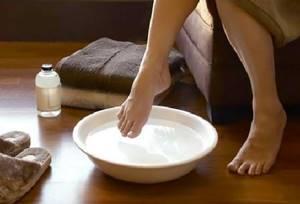
IMPORTANT! This method is only suitable if you have very dry skin WITHOUT CRACKS.
Dissolve 5 tablespoons in warm water, use only apple cider vinegar; its texture is more delicate. Soak your feet in this bath for no more than 10 minutes, and then be sure to apply the cream liberally and let it absorb (without socks). This procedure is not for every day; soften the skin of your heels with this bath 2-3 times a week.
Peppermint for dry feet:

Apply a small amount of peppermint oil to clean feet every day before going to bed or some time before leaving the house in the morning. The antiseptic properties of the oil will not only make the skin smooth, they will give a pleasant smell and prevent bacteria from entering the skin throughout the day. The oil also reduces pain and discomfort.
This is one of the simplest home remedies to treat cracked and rough heels.
Exfoliating homemade foot scrub:
Treat your dry heels with this simple homemade scrub. It will remove the dead layer of skin. Make this scrub by mixing oatmeal with lemon juice, honey and sea salt.
- honey one and a half tablespoons;
- lemon juice - 4 parts lemon;
- oatmeal - half a glass;
- sea salt 1.5 tablespoons.
Keep the scrub on for 30 minutes and then rinse your feet with warm water. Moisturize your feet with mint oil after scrubbing.
Another homemade mask, honey and salt to moisturize and exfoliate the skin on the feet:

Honey has many healing properties and is an excellent product for the skin. Add salt to honey so that the mask has an exfoliating effect, the ratio of components is 1 to 1. Just distribute the mask over your feet and massage your feet, rinse as usual. After the procedure, you don’t need any cream or oil, just put on socks. Do this procedure every day for 10-15 minutes and say “bye” to dry heels.
The best natural moisturizer is milk:
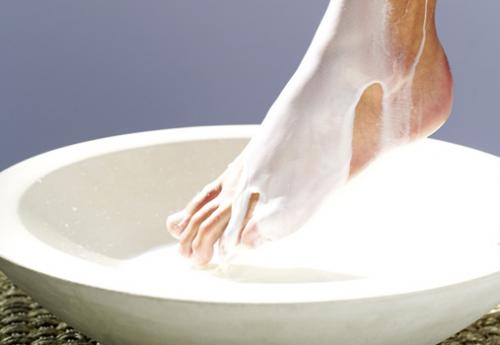
The value of milk for the skin was felt by Cleopatra herself and many women in Egypt. Prepare a warm water bath with a cup of hot milk and 2 tablespoons of sea salt to open the pores. Keep your feet in it for a while. Do this not every day, but only once a week!
Soak your feet in warm water with iodine and salt:

Once or twice a week, soak your feet for 10 minutes in warm water with two tablespoons of sea salt and a tablespoon of iodine. Polish the skin with a grater and apply cream. Do this softening method once a week.
Caring for calluses on feet at home:

If you have problems with calluses or corns, use a small finger grater.
You will need:
- finger grater;
- remover (a professional product for softening corns and skin);
- oil to add to water (or honey);
- moisturizer (oily texture).
On dry skin, apply the remover to the roughest areas of the skin, hold for 5 minutes and immerse your feet in warm water with oil. Steam for 7-10 minutes and lightly rub them with a grater, rinse off the removed skin, dry your feet from moisture and apply cream (no need to wear socks). Repeat the procedure if corns appear, usually once every two weeks.
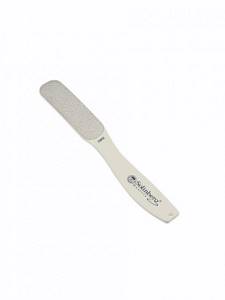
Toe hygiene - remove all excess with an orange stick:
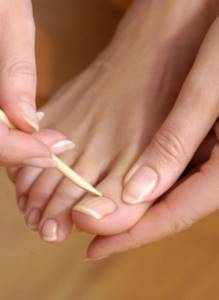
Take an orange stick, steam your toes in a warm bath with aroma oil and sea salt to clean all the dirt from your toenails. Be very careful not to inject yourself. You can also use steel tools, but an orange stick is completely harmless. Use one stick only once.
Removing hangnails and cuticles:
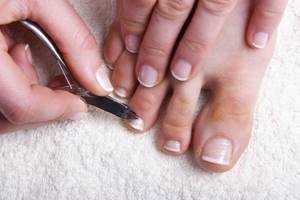
Clean hangnails and cuticles quickly and easily with a cuticle remover. After you have steamed your feet and cleaned your nails, carefully remove, push back and cut off the cuticles with clippers. You don't have to push the cuticle to the base of the nail if it's very small.
Trim your nails regularly:
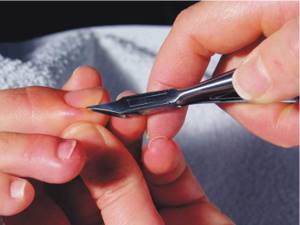
You should trim your toenails at least once every two weeks. Long toenails are not very hygienic and even unsafe, since they can push against shoes and deform their growth, this often leads to this. that the nails begin to grow into the skin. You need to cut your nails carefully, especially at the free edge (in the corners). Do not cut your nails too short; it is better to remove the main length with a tool and then shape it with a nail file.
Polish the surface of your nails with a buff:
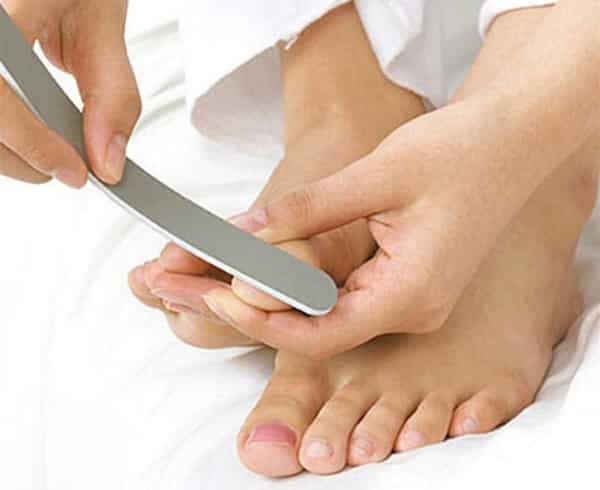
Polishing your toenails is just as important as your fingernails. This should be done in the same way as on your hands.
The problem of sweaty feet:
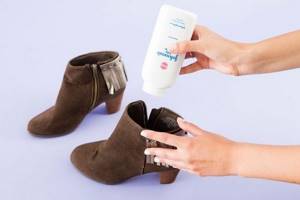
If your feet sweat and smell bad, then you need to wear shoes that “breathe” to work. Apply talcum powder to the inside of your shoes (if you wear shoes on bare feet) or sprinkle talcum powder on the bottom of your feet (if you wear socks). This will absorb sweat and get rid of bad odor. You can also rub two drops of pure sandalwood, lavender or peppermint oil on your feet before putting on your shoes.
Base coat of nails:
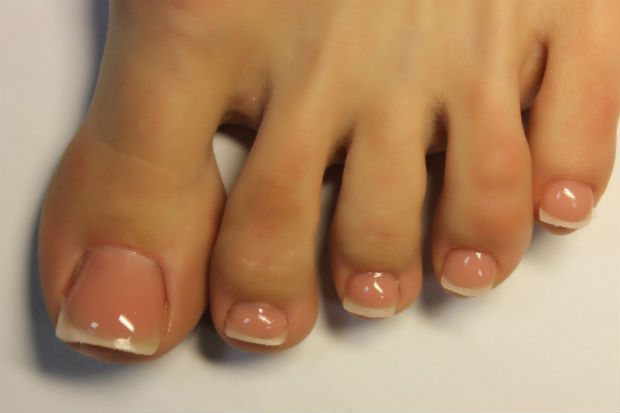
If you're not in the habit of painting your toenails, but you like a neat pedicure, try painting them with a clear polish. This will give a healthy, natural look to your toenails.
To keep your feet soft and healthy, take care of your shoes:
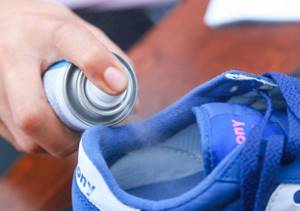
Be sure to use antibacterial sprays for shoes, especially closed ones. It will remove the unpleasant odor and the bacteria that causes it (if you have such a problem). It can also be used for preventive purposes. Before use, read the instructions from the manufacturer you purchased.
These simple methods will help restore and maintain softness to the skin of your feet, as well as maintain neatness and beauty until your next full pedicure.
Treatment of cuticles on legs
How to do a pedicure at home with your own hands? The step-by-step instructions involve removing the skin around the nail. To do this, you can use tweezers, thin scissors, special cutting blades for nails and other devices.
Carefully trim away excess skin, being careful not to damage sensitive areas. If you use special compounds to soften the cuticle, some of them can independently corrode the rough areas. All you have to do is wipe the treated skin with a soft cloth. If you accidentally damage your skin while working, use peroxide or alcohol. Be sure to disinfect the wound and stop the bleeding.
V stage. Cuticle trimming
Using a wooden stick or a special manicure stick with a rounded top, the cuticle must be lifted very carefully so as not to injure the already treated skin and nails. Then, using the selected tool (scissors, nippers, trimmer), carefully trim the cuticle. If there are hangnails on the toes, they are also cut off and treated with a disinfectant.
Many doctors do not recommend cutting the cuticle on the nails, since this method of removal provokes its strong growth, however, cutting the cuticle is still the most popular method of nail care.
119 best hair masks
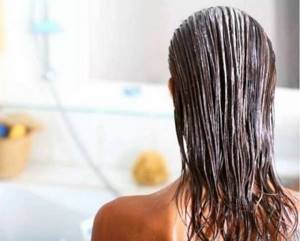
Tidy up your nails
Step-by-step pedicure instructions indicate mandatory nail treatment. Carefully give the plates the same shape and length. To do this, use a file, tweezers or scissors. Toenails are always coarser and thicker than those on the upper limbs. This is why they require polishing. Using a hard buff, file off the top layer of your nails. After this, sand the plates with a fine-grained surface.
Applying varnish or any other coating should be done only after the feet have been completely treated. Degrease the plate first. If you use gel formulations, you will need a special lamp.
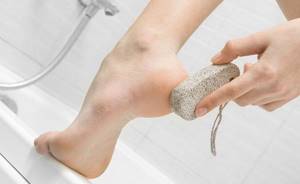
Stage VI. Care and relaxation
What could be better than a foot massage after a pedicure? Only massage with nourishing cream or oil. A care product is applied to the skin, which should be rubbed in with massaging movements until completely absorbed. This procedure is not only useful, but also very pleasant.
At the end of all procedures, you should not leave your nails without coating; with it, their well-groomed appearance will remain for a longer period. It is not necessary to choose bright, colored varnishes - you can limit yourself to applying a transparent base or a special strengthening varnish. Well, if a pedicure seems incomplete without a colored coating and toenail design, you can give free rein to your imagination.
You need to give yourself a trim pedicure at home at least once a month. To keep your feet in good condition, you need to regularly give them baths with herbs or sea salt, remove emerging cracks with a sanding file, and apply nourishing creams. With proper care, your legs will not cause any inconvenience, and will delight the eye with their well-groomed appearance every day.
Particular attention to feet and heels
How to do a pedicure at home with your own hands? The step-by-step instructions indicate that you need to pay special attention to rough areas. These are heels, calluses and corns. To remove the latter, you can use special compounds. They are sold in almost every cosmetic store or pharmacy. Depending on your preferences, you can choose the appropriate tools to clean the specified areas.
Using a metal file or pumice stone, remove plaque and rough skin. This method of work is suitable for those people who regularly carry out preventive measures. When the legs are in disrepair, you will have to try to bring them into proper shape. For this purpose, special blades, scrapers and tweezers are used. Carefully cut off the top rough skin. Try to do all movements very carefully. Upon completion of the manipulation, walk with a soft pumice stone and remove any small particles.
How to give yourself a pedicure without mistakes
Here are some more professional tips from a podiatrist for performing an at-home pedicure.
- Do not use the device. Working with it requires skills, and if you try to treat a foot or nail without experience and understanding of the technique, you can injure yourself. Hardware pedicure is performed with metal cutters that rotate quickly. You need to control the rotation speed and pressing force. Inaccurate movement of the cutter can damage the integrity of the nail plate, undermining its side part or “root”. And then it will take several months to restore the damaged nail.
- Don't try to remove more. If you haven't worked on your heels for a long time, the first pedicure after a break should be gentle. Go through the file lightly, removing only the very top rough layer. Don't try to scrape away dead tissue with a razor blade or scrub too hard to get baby's pink heels. The fact is that the skin of the feet gets used to certain conditions. If it is covered with “coarsened armor” for a long time, it becomes thin and delicate. And if this “armor” is peeled off at one point, the skin will definitely burst. And you will have to suffer from a painful crack for several weeks. Remove the stratum corneum gradually, over two or three procedures. This way you will accustom your legs to new “conditions” and will not get unpleasant consequences.
- Assess the condition of your feet correctly. Some people have naturally thick nail plates. It often thickens with age, and cutting off the tip of a dry nail with nail clippers becomes almost impossible. In this case, the legs need to be soaked first, and only then work with the nails.
- Don't cut your nails too short. As a rule, low cutting of the nail plate leads to its ingrowth and the appearance of foci of inflammation at the junction with the fingertips. As much as you'd like to return to pedicures as rarely as possible, leave a small nail tip on each toe. One or two millimeters will be enough.
If you do not have problems with your feet, regular care treatments at home will help you maintain their beauty and health. But if you have calluses, corns form quickly, or painful cracks appear, you cannot do without professional care. In this case, you need to contact a professional as needed, and between visits to the salon, take care of your legs at home yourself.

pixabay.com/
Step-by-step instructions for hardware pedicure
To perform this type of foot treatment, you must have a special device. Many beauty salons use professional machines with attachments of different shapes and hardness. Some of them are designed to cleanse nails, while others treat feet.
Currently, pedicure files that are small in size and run on batteries are becoming very popular. One of these is Scholl, but you can try Aphrodite or Solingen. Step-by-step instructions (how to do a pedicure) are always on the package. Before starting work, carefully study it and comply with all conditions. But what about those devices that do not have an annotation?
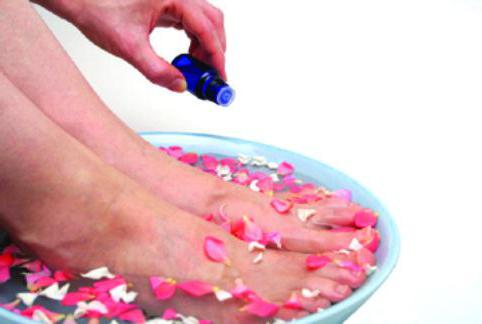
Varieties
Pedicures vary in the way they treat nails and feet. The most common are classic pedicure and hardware treatment of feet and nails. There is also a combined pedicure, when both technologies are combined.
A separate category includes SPA pedicure, using various oils, exfoliating masks and SPA treatments with socks soaked in healthy oils, acids and other components.
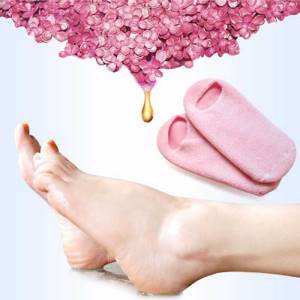
@modnapionia
There is also a type of foot and nail treatment called European. European pedicure is characterized by the treatment of nails without the use of any cutting objects. This type of pedicure is also called “unedged”.
When performing an unedged pedicure, the cuticle is softened with special means and then pushed back, the nails and rough skin are polished with a nail file, and the feet are treated with special compounds that soften the keratinized skin. The old skin is then removed with a pumice stone and covered with a nourishing moisturizer.
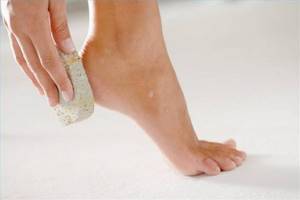
@pedikur_doma
For the most sophisticated women who want to try something new in the field of pedicure, masters offer 3 more types of procedures:
- "Chocolate" pedicure. When using it, a classic pedicure is accompanied by a chocolate wrap, baths or application of chocolate lotion, which moisturizes the skin of the feet and cuticles.
- Pedicure with Garra Rufa fish. The client places her feet in a special pool in which small fish swim, biting off dead skin particles from the feet, as well as dirt. The procedure is completely painless, on the contrary, very pleasant and relaxing.
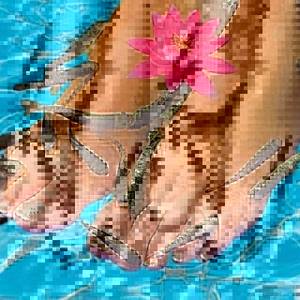
@dneprnow
- Pedicure with ice cream. The pedicurist adds several scoops of special ice cream made from natural oils to a compact foot bath. The balls slowly melt in water, nourishing the skin of the feet and nails. After the procedure, the legs are treated with a special sugar-based scrub.
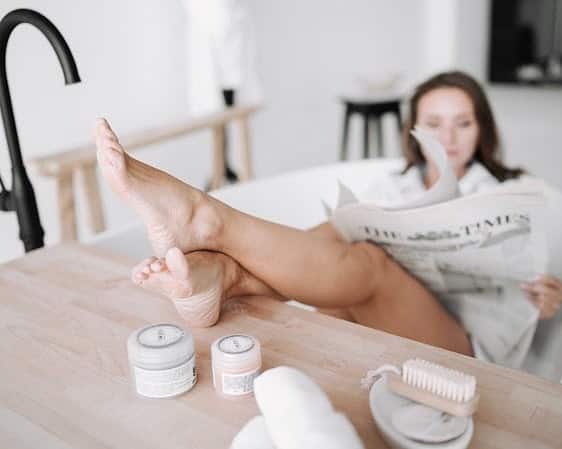
@bogika_cosmetics
Skin care using the device
Take the coarsest nozzle and treat especially problem areas with it. These are heels, dry calluses and corns. After this, use the nozzle to gently go over the entire skin. Remember that when doing a hardware pedicure, you can’t stop at one place. A rotating file can severely damage the skin. That is why all movements must be made carefully, moving slowly in a certain direction.
Once the rough layer of skin has been removed, you need to put on the sanding attachment and complete the pedicure. This type of file can be used to process the inside of the toes and the center of the foot.

Stage III: Peeling
A special foot peeling is applied to the dried skin. It helps remove dead cells in the most difficult to reach places (between the toes and in the micro-folds of the foot). You can buy a foot peeling product in the store, or you can make it yourself: take some kind of oil as a base, add coffee grounds, candied honey, sugar, oatmeal and other ingredients that depend only on personal desires and taste. Thoroughly treat your feet with the resulting mixture for 2 - 3 minutes, and then rinse it off.
What to do with your nails?
How to do a pedicure at home with your own hands? The step-by-step instructions say the following. The nail plate, like the rest of the skin, must be treated using attachments. However, they are smaller in size and have a different shape. Gently file away the cuticle without affecting sensitive areas and delicate skin.
The surface of the nails must be sharpened using a special attachment. After this, polish. Finally, you can apply the coating.
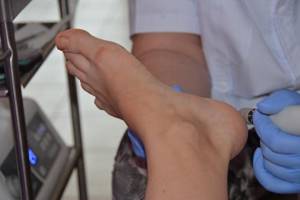
Recommendations for performing different types of pedicure at home
Adhere to the following rules:
- If you perform the manipulation yourself, you should always disinfect the instruments. Even nail files for hardware manicure can be processed. Otherwise, a fungus may develop on them, which is very difficult to remove.
- Do not use other people's pedicure products. When you come to the salon to have a specialist work on your beauty, always make sure that the equipment used is clean.
- Try to file your nails first, then perform softening procedures. Otherwise, the plate may begin to delaminate and crumble.
- Avoid trimming sharp corners of your nails. This can lead to the formation of ingrown toenails. This pathology causes a lot of inconvenience. In some cases, a person simply cannot move normally.
- If you use oil-based compounds, you should always wipe your nails with a degreaser before applying the coating. Otherwise, the varnish and gel simply won’t stick.
- When applying gel substances to your nails, sand the plate first to ensure a stronger adhesion.
- Use moisturizing and nourishing products after a pedicure, do not forget to treat the cuticle. It is worth noting that such compositions should be used not only after the described manipulations. Moisturizing your feet daily will help prevent dry, cracked feet.
- Perform a light pedicure at least once every two months. This will allow you to avoid the occurrence of corns, calluses and rough skin.
How often to get a pedicure
Another misconception is that the procedure should only be done in the summer. And in winter you can “save” on it, since no one can see your legs anyway. According to Anna Shevchuk, this opinion can result in serious health problems.
“Pedicures should be done at any time of the year,” the expert clarifies. — On our feet, regardless of whether we walk barefoot or in closed shoes, a stratum corneum constantly appears. And it must be removed regularly. If this is not done, corns will appear. And they will begin to crack and cause pain. This usually happens in the summer when we wear open shoes. But in winter the problem is no less pressing. Due to the operation of the heating system, the air in the rooms becomes dry and the skin dries out intensely. Therefore, cracks in the heels often appear in winter, with the beginning of the heating season. And a pedicure will help prevent their occurrence.”
The recommended frequency of performing the procedure is once every 28 days. In some cases it may be required more often. For example, in people with metabolic diseases, the intensity of the appearance of rough skin is higher, and pedicures must be performed every three weeks.
The expert recommends that people suffering from diabetes mellitus take more care of their feet. Due to the peculiarities of metabolic processes and circulatory disorders in this disease, the legs are especially susceptible to wounds and injuries. Those who are overweight also need to pay attention to their legs. Excessive pressure on the feet creates areas of intense roughening of the skin. And in these areas the risk of cracks increases.
Regularity is also determined by the rate of nail growth, which does not always coincide with the formation of the stratum corneum on the heels. Nails grow faster in summer, but in winter their growth rate slows down. Therefore, you can contact the master a little less often. But low-quality shoes or models that do not fit in size or instep height can cause not only discomfort when walking, but also lead to impaired foot health.

pixabay.com/
“In the absence of good shoes, your feet seriously suffer,” explains Anna Shevchuk. - Painful calluses form. And it is impossible to cope with them at home on your own. You just need to go to the salon, to a master podiatrist.”
If you make regular foot care a daily habit, the frequency of visits to a professional can be reduced. Home treatments will help maintain healthy feet, their beauty and well-groomed appearance.

